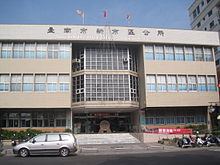Area 47.81 km² | Platforms in use 1 | |
 | ||
Operator Taiwan Railways Administration | ||
Sinshih District (Chinese: 新市區; Hanyu Pinyin: Xīnshì Qū; Tongyong Pinyin: Sinshìh Cyu; Wade–Giles: Hsin1-shih4 Ch'ü1; Pe̍h-ōe-jī: Sin-chhī-khu; literally: "new market") is a rural district in central Tainan, Taiwan, about 11 km north of Fort Provintia. As Sincan, it was one of the most important stations of the Dutch East India Company (VOC) in the 17th century. Missionary work formally began and the largest amount of inland trade occurred at Sinkan.
Contents
- Map of Xinshi District Tainan City Taiwan 744
- Name
- History
- Geography
- Economy
- Education
- Tourist attractions
- Transportation
- References
Map of Xinshi District, Tainan City, Taiwan 744
Name
The village name of Sincan has also been recorded as Sinckan, Cinckan, Xincan, and Zinckan. The place shares the same namesake as the Sinckan language and Sinckan Manuscripts. After the Kingdom of Tungning, the name was Sinicized into Sin-kang (Chinese: 新港; pinyin: Xingang; Pe̍h-ōe-jī: Sin-káng; literally: "new harbor/new inlet").
History
Located about 7 miles (11 km) north of Sakam (see Fort Provintia), Sinkan was one of the most important stations of the Dutch during the 17th century. Sinkan was the smallest of four main aboriginal villages near the Dutch base at Tayouan, with around 1,000 inhabitants. This fact led them to seek friendship and protection from the Dutch; Sinkan was the VOC's closest ally.
In 1861 Consul Robert Swinhoe arrived at Taiwan-fu (modern-day Tainan) and became the first European writer to come into contact with the Taiwanese aborigines after Maurice Benyovszky in 1771. Swinhoe wrote that he was informed by a "thoroughly Chinese-looking" military officer that his ancestor was one of 3,000 Dutch soldiers remaining in the island during the reign of Koxinga (and after Dutch rule), and that his village of Sinkang was chiefly composed of the soldiers' descendants.
Geography
Economy
Part of Tainan Science Park, which was founded in 1996, lies within Xinshi.
